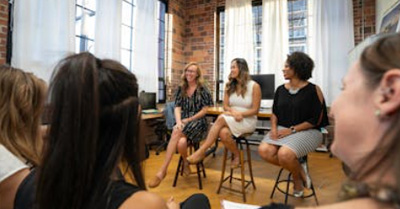The present continuous tense (also known as the present progressive tense), is used to talk about an action or event in the present time frame, that is, an action or event going on in the present or right now.
In this lesson, learn the different uses of the present continuous tense in its affirmative, interrogative, and negative forms.

RUN4FFWPU | Pexels
The Time Frame of the Present Continuous Tense
The names “present continuous” or “present progressive tenses” reflect what this verb tense expresses, that is, an action or event that is in progress. The action started at an undefined time and continues to happen at this very moment.
In that sense, this is the verb tense that is truly about the present. (Compare it to present simple tense, which is not really about the present.)
However, the present continuous tense can express certain nuances and place the verb in different time frames.
Affirmative, Negative, and Interrogative Forms
Use the auxiliary verb be and the gerund (verb in the -ing form) to ask questions and to form the negative form of the present continuous tense.
- Affirmative, interrogative, and negative forms of the present simple
-
The students are taking exams right now.
— Are the students watching a lecture?
— No, they aren’t. They are taking their finals.
-
The plane is leaving in an hour.
— Is the plane arriving soon?
— No. It’s not arriving until late tonight.
Uses of the Present Continuous Tense
We use the present continuous tense to express:
- A state, action or event happening now,
- An state, action or even happening around the present,
- A change starting around the present and still ongoing,
- An repetitive or excessive state, action or event that may annoy or disturb you,
- A future arrangement, and
- Something happening in the immediate future.
Expressing an ongoing state, action, or event
The present continuous tense refers to states, actions, or events happening in the present time frame, that is, right now.
It may have started some time before now, and it may continue into the future, but the main idea is that it is ongoing at this very moment.

Dani Hart | Pexels
- Expressing an ongoing state, action, or event
- The school is closed today. The teachers are attending staff development sessions.
- You are just being stubborn now. You insist on making that point even though you know you are wrong.
- The crowd is being very inconsiderate. They are talking loudly while the speaker is trying to deliver her speech.
Expressing a State, Action, or Event Happening Around the Present
In this sense, the present continuous tense is used with time adverbs such as today, this month, this week, this semester, this quarter, and so on.
- Expressing something happening around the present
- My students are having a hard time getting organized this semester.
- Congress is working hard at doing nothing this year.
- Dr. Ecks’s patient isn’t doing very well today. He is complaining about abdominal pain.
- Low-income families are not doing very well financially due to the increase in cost of living this year.
Expressing an Ongoing Change
The present continuous tense can be used when you talk about a change happening now. It may have started recently, but the focus is that the change is ongoing.
Verbs commonly used in the present continuous tense to express this idea include becoming, beginning, changing, decreasing, getting, growing,
- Expressing an ongoing change
- Your scores are improving steadily now because you are beginning to grasp these concepts more deeply than ever before.
- As gas prices are slowly decreasing now, Americans are starting to travel more often.
- The patient’s health is improving steadily. He is starting to walk on his own.
- My English is getting better because I’m using Snap Language materials.
Expressing Excessive or Repetitive States, Actions, or Events
When used with always, the present continuous tense sometimes expresses the idea something keeps happening, which you may find annoying or disturbing to some degree. This sense of the present continuous depends on the context.
For example, if you say, “A good entrepreneur is always looking for new opportunities,” there is a sense of ongoing repetition but without expressing annoyance.
- Expressing excessive or repetitive states, actions, or events
- Young people are always looking at their phone rather than connecting with the people who are in the room with them.
- Senator Ecks is constantly complaining about how the media treats him unfairly.
- You’re always criticizing people for their life choices. Why don’t you just accept people have the right to do whatever they want?
- You are always losing your phone! You need to be more careful.
Expressing future plans or arrangements
In this sense, the present continuous is used when an action or event has been planned or arranged previously.
- Expressing planned or arranged actions or events
- The president is visiting Germany next week. (The trip has been arranged.)
- My CEO is leaving the company this month. (The CEO’s departure has been planned.)
- We are interviewing the job applicants for the next two days. We’re making a final decision by Friday. (Everything has already been scheduled.)
- I’m taking the morning flight to San Francisco tomorrow. (I have already made all the arrangements.)
- I’m not going to the party tomorrow. I’m staying home this weekend. (I already planned my weekend.)
Expressing the Immediate Future
In this sense, the present continuous is when an action or event is happening in the immediate future. It often involves a decision made at the moment.
- Expressing the immediate future
-
— Hurry! The plane is leaving in an hour.
— I just decided I’m not leaving today. I’m taking an early flight tomorrow.
— I hope the flight isn’t sold out.
— I’m calling the airline right away.
-
— Glad you’re finally home. We’re having dinner in 20 minutes.
— I’m taking a quick shower and changing into something comfortable. I’ll join you in a minute.
Practice
Practice 1. Practice using the present continuous tense with multiple meanings.
Congratulations on completing this lesson!

Thanks to our supporters!
This material has been made possible by supporters like you. Learn how you can support us.

“What should I learn next?”
Use the navigation buttons to choose another skill or another lesson in this skill.
Thank you for Supporting Snap Language
Snap Language supporters make the creation of these materials possible.
Learn how you can support our work, get perks, and help us continue creating high-quality materials.
You can support us by simply white-listing this site.